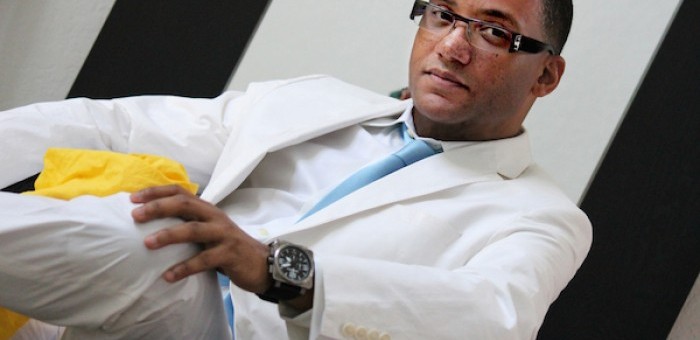Apr 2, 2024 12:59 PM
Saxophonist, Sonic Explorer Casey Benjamin Dies at 45
Casey Benjamin, the alto saxophonist, vocalist, keyboardist and producer who stamped his distinctive sounds on the…

Gonzalo Rubalcaba
(Photo: Courtesy of g-rubalcaba.com)Flamenco has a firm foothold in the Bay Area, thanks to the 11th Annual San Francisco Flamenco Festival, which concluded on March 9 with a concert at the Herbst Theatre. Vocalist Esperanza Fernández and pianist Gonzalo Rubalcaba headlined a dual tribute to the Cuban sonero Beny Moré (1919–’63) and the Spanish Gypsy cantaor Manolo Caracol (1909–’73) dubbed “¡Oh Vida!” with Fernández serving as Artistic Director and Rubalcaba the event’s Musical Director.
Both pairings proved to be a perfect fit. Contemporaries, Moré and Caracol were popular entertainers as well as performing artists. Fernández and Rubalcaba, in turn, are each virtuosos comfortable investigating disparate musical styles and traditions.
During her introduction, Bay Area Flamenco Artistic and Executive Director Nina Menéndez explained that Fernández had performed at last year’s San Francisco Music Festival and mentioned she was pondering working on this project with Rubalcaba.
Menéndez first met Rubalcaba in Havana back in the late ’80s when he and her brother, guitarist Pablo Menéndez, played together in the band Sonidos Contemporáneos. In an earlier statement she expressed her enthusiasm about the possible collaboration and was able to present the project a mere five days after its March 4 debut in Miami.
The venue was darker than usual as the musicians, including bass guitarist J.M. Popo and percussionists Jorge “El Cubano” Pérez and José Fernández (no relation to Esperanza) took their places on the bandstand. It evoked an after-hours mood as various colored lights would illuminate the musicians in a minimalist fashion.
Rubalcaba alone was visible stage right as he provided an unaccompanied introduction to the evening’s titular bolero, a signature song of Moré’s. Utilizing soft chords and delicate single note excursions, he established an elegant, sweeping template.
Fernández’s impassioned crooning then cut across the rhythm section’s understated accompaniment. She clapped in syncopated support while Rubalcaba executed a surgically economical solo. Addressing the audience in Spanish, she then let Rubalcaba start the next number—“Popurrí de Zambras” from Caracol’s songbook. His sinuous lines contrasted with her sustained, horn-like singing.
When he soloed precisely and quietly, she accompanied with graceful dance-like arm movements. Though Rubalcaba enjoys a reputation as a mighty technician, he reminded listeners early on of the equally impressive delicately restrained aspect of his pianistic approach.
Pérez and José Fernández’s arsenal included cajons, congas and their own bodies. The two percussionists were energetic standouts on an infectious version of “Yiri-Yiri Bon.”
Even for non-Spanish speakers, Esperanza Fernández’s vocal delivery conveyed the sassy and assured lyrics. She reinforced a feeling of sensuality through her own brief expressive dance that preceded a Rubalcaba solo featuring crisp arpeggios.
Popo had he honor of doing the first non-Rubalcaba solo introduction of the set for Moré’s “Tú Me Sabes Comprender.” Manipulating the volume of his instrument, he made these abstract explorations sound like ocean waves.
In a true cultural crossover moment, Rubalcaba then played with a rapidity and fluidity that made the piano sound as if it was a strummed acoustic guitar. In a musically intimate moment, Fernández walked over to the pianist, turned to him while remaining in profile to the audience and seemingly serenaded her creative partner.
For the first of two medleys, Moré’s “¿Como Fue?” was partnered with Caracol’s “Gitana Blanca.” Popo again played first, plucking successive notes for another wet effect—a soft constant rain in this case. Esperanza Fernández snapped in time and then danced during Rubalcaba’s expansive solo.
In the latter segment, Fernández got her own solo showcase followed by an exquisite passage with just her and the two percussionists. Pérez and José Fernández were featured throughout the rest of the night.
The other medley, Moré’s “Santa Isabel de Las Lajas” and Caracol’s “Malva Loca,” closed the formal repertoire with the percussionists holding a de facto master class on clapping before tandem soloing on “Malva Loca” while employing a variety of their instruments.
The quintet was encouraged back to the stage and called an audible by presenting a true encore in the form of another version of “Yiri-Yiri Bon.” This one was shorter and looser, with a quicker tempo and Esperanza Fernández leading the enthusiastic crowd in a clap-along.
It was one final communal moment concluding a spirited and inspired program.

Benjamin possessed a fluid, round sound on the alto saxophone, and he was often most recognizable by the layers of electronic effects that he put onto the instrument.
Apr 2, 2024 12:59 PM
Casey Benjamin, the alto saxophonist, vocalist, keyboardist and producer who stamped his distinctive sounds on the…

“He’s constructing intelligent musical sentences that connect seamlessly, which is the most important part of linear playing,” Charles McPherson said of alto saxophonist Sonny Red.
Feb 27, 2024 1:40 PM
“I might not have felt this way 30 to 40 years ago, but I’ve reached a point where I can hear value in what people…

Albert “Tootie” Heath (1935–2024) followed in the tradition of drummer Kenny Clarke, his idol.
Apr 5, 2024 10:28 AM
Albert “Tootie” Heath, a drummer of impeccable taste and time who was the youngest of three jazz-legend brothers…

“Both of us are quite grounded in the craft, the tradition and the harmonic sense,” Rosenwinkel said of his experience playing with Allen. “Yet I felt we shared something mystical as well.”
Mar 12, 2024 11:42 AM
“There are a few musicians you hear where, as somebody once said, the molecules in the room change. Geri was one of…

Henry Threadgill performs with Zooid at Big Ears in Knoxville, Tennessee.
Apr 9, 2024 11:30 AM
Big Ears, the annual four-day music celebration that first took place in 2009 in Knoxville, Tennessee, could well be…